Queen Matilah International Airport Operations Management Analysis
VerifiedAdded on 2023/06/04
|9
|2203
|491
Report
AI Summary
This report, prepared for the Director General of Queen Matilah International Airport, addresses the need to improve customer satisfaction and operational efficiency. The author, in the role of Director of Operations, outlines a series of technological and infrastructural improvements to meet the standards recommended by ICAO and government regulations. The report emphasizes the importance of Information Technology solutions, including automated scheduling, real-time control systems, and integrated communication systems. Proposed enhancements include improvements to movement areas, automated staff scheduling, and implementation of advanced security measures such as off-site baggage tagging, biometric processing, and intelligent transport systems. The goal is to enhance the overall passenger experience, reduce operational costs, and improve the airport's competitive advantage. The report also covers safety and emergency solutions, emphasizing the need for state-of-the-art technology and a unified approach to airport management. The report concludes by highlighting the strategic role of the operations department in ensuring the airport's long-term success and ability to adapt to the dynamic nature of the aviation industry.
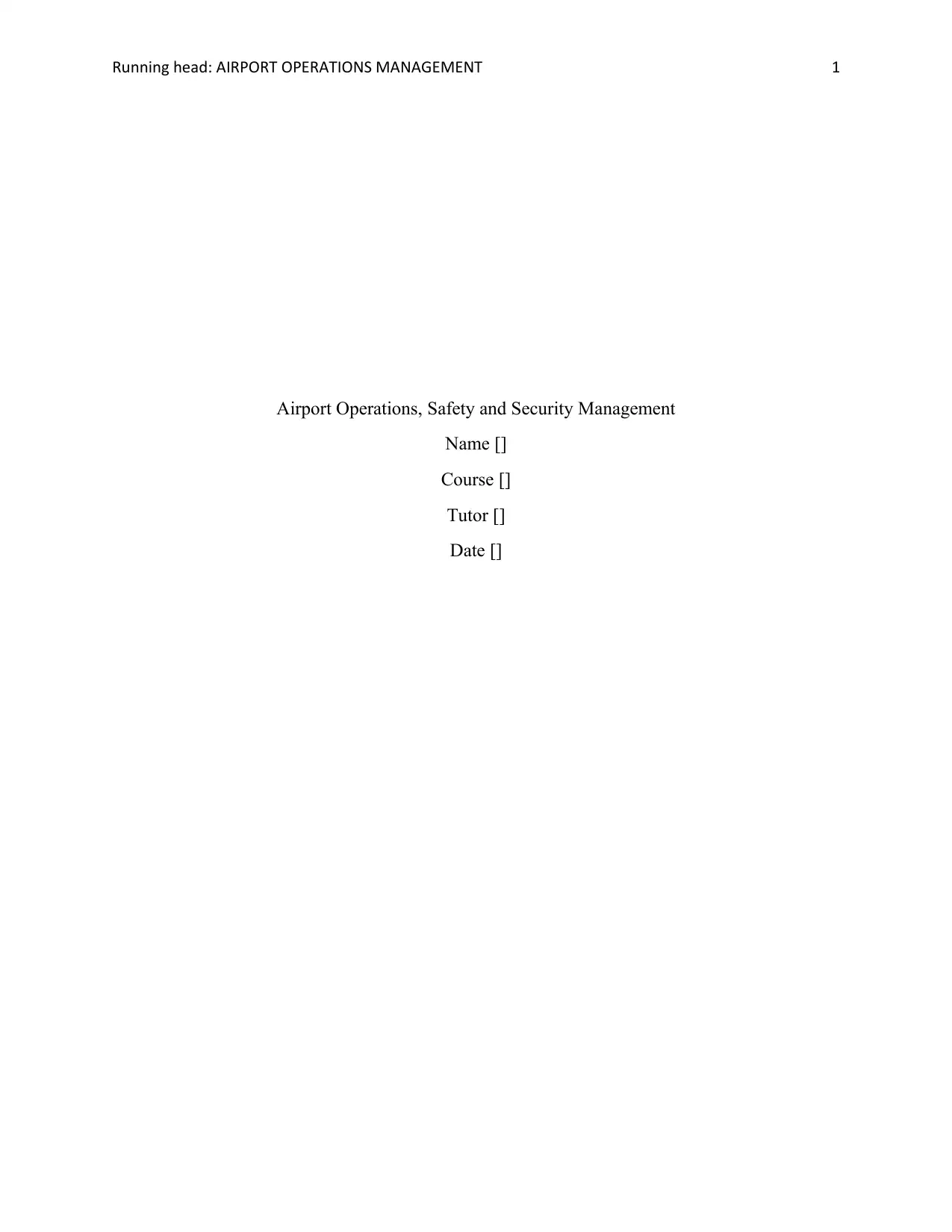
Running head: AIRPORT OPERATIONS MANAGEMENT 1
Airport Operations, Safety and Security Management
Name []
Course []
Tutor []
Date []
Airport Operations, Safety and Security Management
Name []
Course []
Tutor []
Date []
Paraphrase This Document
Need a fresh take? Get an instant paraphrase of this document with our AI Paraphraser
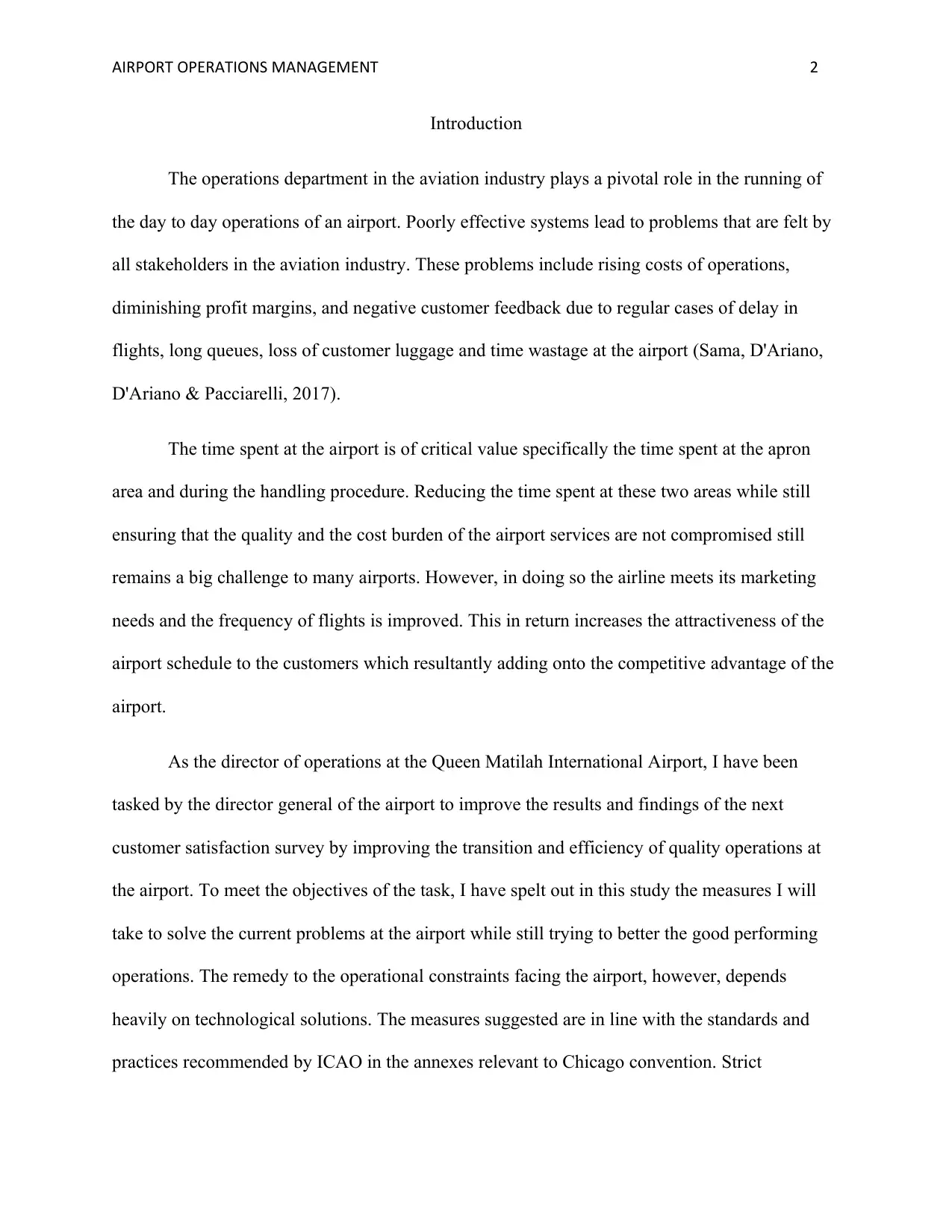
AIRPORT OPERATIONS MANAGEMENT 2
Introduction
The operations department in the aviation industry plays a pivotal role in the running of
the day to day operations of an airport. Poorly effective systems lead to problems that are felt by
all stakeholders in the aviation industry. These problems include rising costs of operations,
diminishing profit margins, and negative customer feedback due to regular cases of delay in
flights, long queues, loss of customer luggage and time wastage at the airport (Sama, D'Ariano,
D'Ariano & Pacciarelli, 2017).
The time spent at the airport is of critical value specifically the time spent at the apron
area and during the handling procedure. Reducing the time spent at these two areas while still
ensuring that the quality and the cost burden of the airport services are not compromised still
remains a big challenge to many airports. However, in doing so the airline meets its marketing
needs and the frequency of flights is improved. This in return increases the attractiveness of the
airport schedule to the customers which resultantly adding onto the competitive advantage of the
airport.
As the director of operations at the Queen Matilah International Airport, I have been
tasked by the director general of the airport to improve the results and findings of the next
customer satisfaction survey by improving the transition and efficiency of quality operations at
the airport. To meet the objectives of the task, I have spelt out in this study the measures I will
take to solve the current problems at the airport while still trying to better the good performing
operations. The remedy to the operational constraints facing the airport, however, depends
heavily on technological solutions. The measures suggested are in line with the standards and
practices recommended by ICAO in the annexes relevant to Chicago convention. Strict
Introduction
The operations department in the aviation industry plays a pivotal role in the running of
the day to day operations of an airport. Poorly effective systems lead to problems that are felt by
all stakeholders in the aviation industry. These problems include rising costs of operations,
diminishing profit margins, and negative customer feedback due to regular cases of delay in
flights, long queues, loss of customer luggage and time wastage at the airport (Sama, D'Ariano,
D'Ariano & Pacciarelli, 2017).
The time spent at the airport is of critical value specifically the time spent at the apron
area and during the handling procedure. Reducing the time spent at these two areas while still
ensuring that the quality and the cost burden of the airport services are not compromised still
remains a big challenge to many airports. However, in doing so the airline meets its marketing
needs and the frequency of flights is improved. This in return increases the attractiveness of the
airport schedule to the customers which resultantly adding onto the competitive advantage of the
airport.
As the director of operations at the Queen Matilah International Airport, I have been
tasked by the director general of the airport to improve the results and findings of the next
customer satisfaction survey by improving the transition and efficiency of quality operations at
the airport. To meet the objectives of the task, I have spelt out in this study the measures I will
take to solve the current problems at the airport while still trying to better the good performing
operations. The remedy to the operational constraints facing the airport, however, depends
heavily on technological solutions. The measures suggested are in line with the standards and
practices recommended by ICAO in the annexes relevant to Chicago convention. Strict
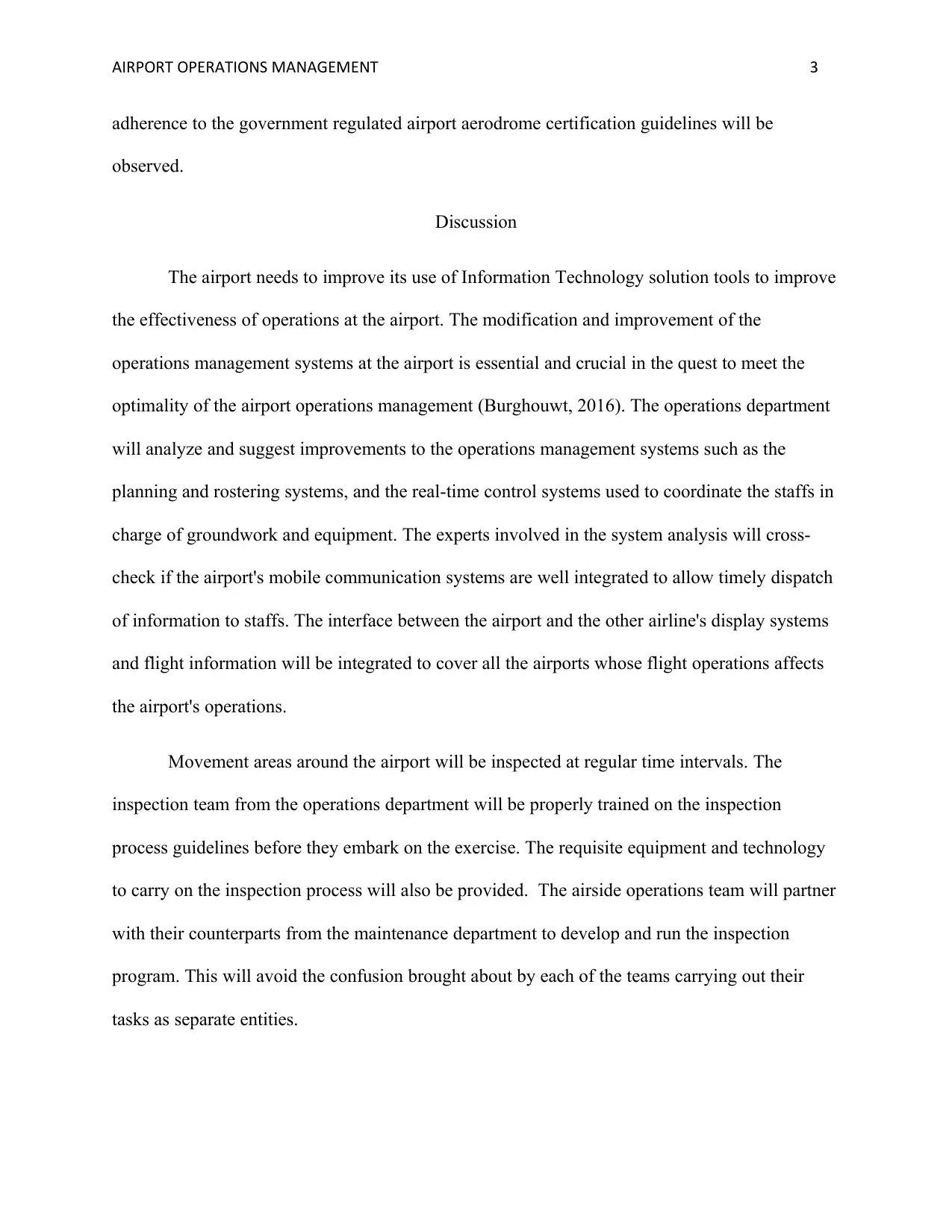
AIRPORT OPERATIONS MANAGEMENT 3
adherence to the government regulated airport aerodrome certification guidelines will be
observed.
Discussion
The airport needs to improve its use of Information Technology solution tools to improve
the effectiveness of operations at the airport. The modification and improvement of the
operations management systems at the airport is essential and crucial in the quest to meet the
optimality of the airport operations management (Burghouwt, 2016). The operations department
will analyze and suggest improvements to the operations management systems such as the
planning and rostering systems, and the real-time control systems used to coordinate the staffs in
charge of groundwork and equipment. The experts involved in the system analysis will cross-
check if the airport's mobile communication systems are well integrated to allow timely dispatch
of information to staffs. The interface between the airport and the other airline's display systems
and flight information will be integrated to cover all the airports whose flight operations affects
the airport's operations.
Movement areas around the airport will be inspected at regular time intervals. The
inspection team from the operations department will be properly trained on the inspection
process guidelines before they embark on the exercise. The requisite equipment and technology
to carry on the inspection process will also be provided. The airside operations team will partner
with their counterparts from the maintenance department to develop and run the inspection
program. This will avoid the confusion brought about by each of the teams carrying out their
tasks as separate entities.
adherence to the government regulated airport aerodrome certification guidelines will be
observed.
Discussion
The airport needs to improve its use of Information Technology solution tools to improve
the effectiveness of operations at the airport. The modification and improvement of the
operations management systems at the airport is essential and crucial in the quest to meet the
optimality of the airport operations management (Burghouwt, 2016). The operations department
will analyze and suggest improvements to the operations management systems such as the
planning and rostering systems, and the real-time control systems used to coordinate the staffs in
charge of groundwork and equipment. The experts involved in the system analysis will cross-
check if the airport's mobile communication systems are well integrated to allow timely dispatch
of information to staffs. The interface between the airport and the other airline's display systems
and flight information will be integrated to cover all the airports whose flight operations affects
the airport's operations.
Movement areas around the airport will be inspected at regular time intervals. The
inspection team from the operations department will be properly trained on the inspection
process guidelines before they embark on the exercise. The requisite equipment and technology
to carry on the inspection process will also be provided. The airside operations team will partner
with their counterparts from the maintenance department to develop and run the inspection
program. This will avoid the confusion brought about by each of the teams carrying out their
tasks as separate entities.
⊘ This is a preview!⊘
Do you want full access?
Subscribe today to unlock all pages.

Trusted by 1+ million students worldwide
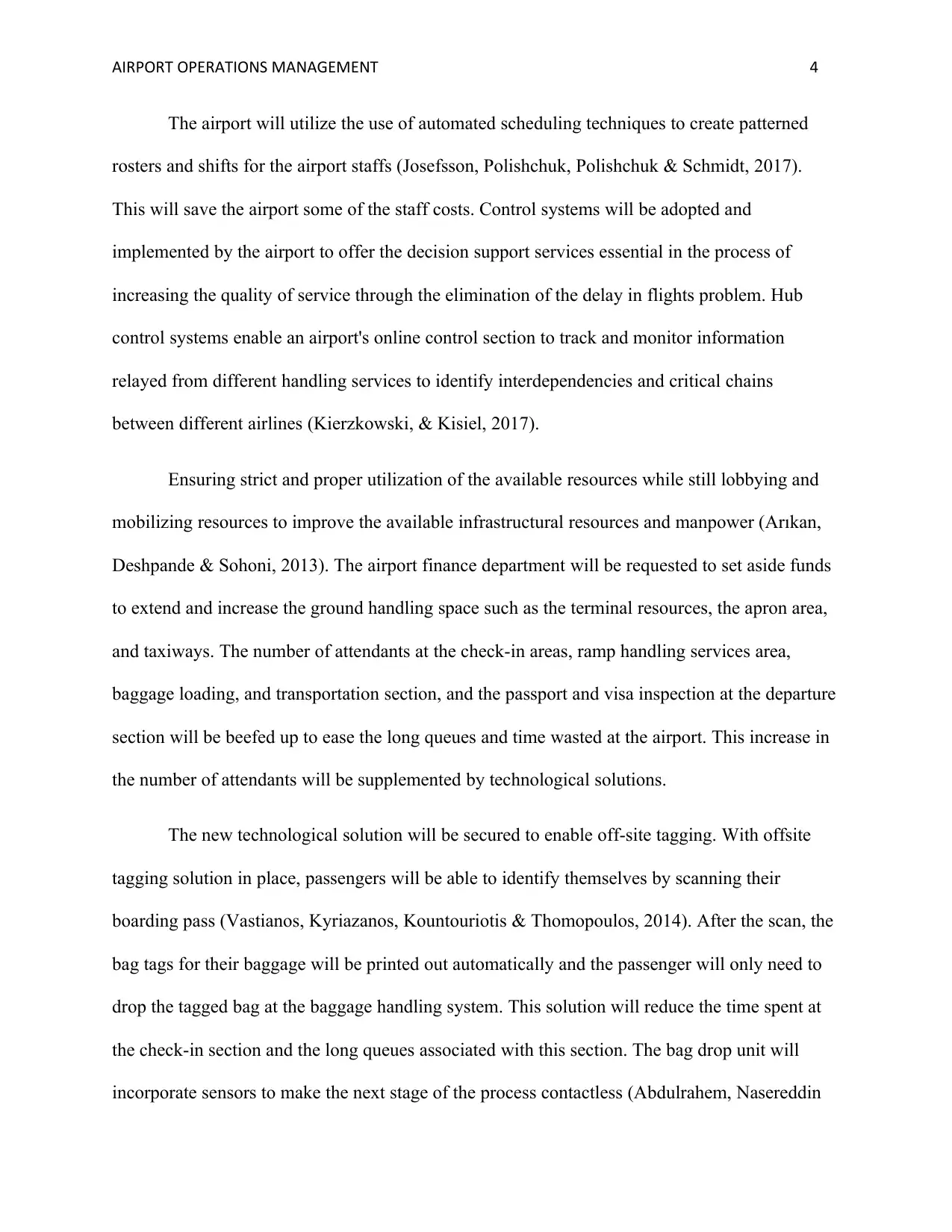
AIRPORT OPERATIONS MANAGEMENT 4
The airport will utilize the use of automated scheduling techniques to create patterned
rosters and shifts for the airport staffs (Josefsson, Polishchuk, Polishchuk & Schmidt, 2017).
This will save the airport some of the staff costs. Control systems will be adopted and
implemented by the airport to offer the decision support services essential in the process of
increasing the quality of service through the elimination of the delay in flights problem. Hub
control systems enable an airport's online control section to track and monitor information
relayed from different handling services to identify interdependencies and critical chains
between different airlines (Kierzkowski, & Kisiel, 2017).
Ensuring strict and proper utilization of the available resources while still lobbying and
mobilizing resources to improve the available infrastructural resources and manpower (Arıkan,
Deshpande & Sohoni, 2013). The airport finance department will be requested to set aside funds
to extend and increase the ground handling space such as the terminal resources, the apron area,
and taxiways. The number of attendants at the check-in areas, ramp handling services area,
baggage loading, and transportation section, and the passport and visa inspection at the departure
section will be beefed up to ease the long queues and time wasted at the airport. This increase in
the number of attendants will be supplemented by technological solutions.
The new technological solution will be secured to enable off-site tagging. With offsite
tagging solution in place, passengers will be able to identify themselves by scanning their
boarding pass (Vastianos, Kyriazanos, Kountouriotis & Thomopoulos, 2014). After the scan, the
bag tags for their baggage will be printed out automatically and the passenger will only need to
drop the tagged bag at the baggage handling system. This solution will reduce the time spent at
the check-in section and the long queues associated with this section. The bag drop unit will
incorporate sensors to make the next stage of the process contactless (Abdulrahem, Nasereddin
The airport will utilize the use of automated scheduling techniques to create patterned
rosters and shifts for the airport staffs (Josefsson, Polishchuk, Polishchuk & Schmidt, 2017).
This will save the airport some of the staff costs. Control systems will be adopted and
implemented by the airport to offer the decision support services essential in the process of
increasing the quality of service through the elimination of the delay in flights problem. Hub
control systems enable an airport's online control section to track and monitor information
relayed from different handling services to identify interdependencies and critical chains
between different airlines (Kierzkowski, & Kisiel, 2017).
Ensuring strict and proper utilization of the available resources while still lobbying and
mobilizing resources to improve the available infrastructural resources and manpower (Arıkan,
Deshpande & Sohoni, 2013). The airport finance department will be requested to set aside funds
to extend and increase the ground handling space such as the terminal resources, the apron area,
and taxiways. The number of attendants at the check-in areas, ramp handling services area,
baggage loading, and transportation section, and the passport and visa inspection at the departure
section will be beefed up to ease the long queues and time wasted at the airport. This increase in
the number of attendants will be supplemented by technological solutions.
The new technological solution will be secured to enable off-site tagging. With offsite
tagging solution in place, passengers will be able to identify themselves by scanning their
boarding pass (Vastianos, Kyriazanos, Kountouriotis & Thomopoulos, 2014). After the scan, the
bag tags for their baggage will be printed out automatically and the passenger will only need to
drop the tagged bag at the baggage handling system. This solution will reduce the time spent at
the check-in section and the long queues associated with this section. The bag drop unit will
incorporate sensors to make the next stage of the process contactless (Abdulrahem, Nasereddin
Paraphrase This Document
Need a fresh take? Get an instant paraphrase of this document with our AI Paraphraser
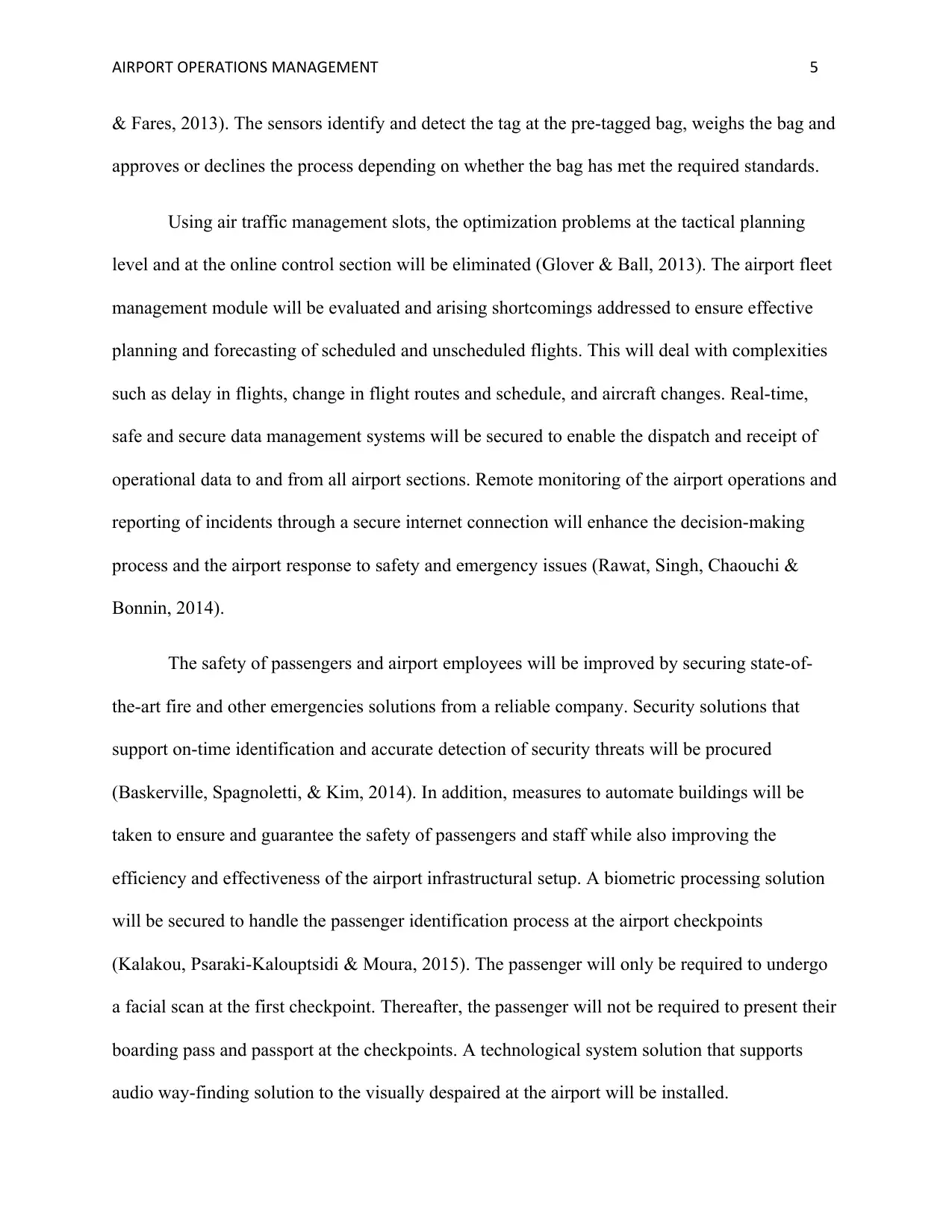
AIRPORT OPERATIONS MANAGEMENT 5
& Fares, 2013). The sensors identify and detect the tag at the pre-tagged bag, weighs the bag and
approves or declines the process depending on whether the bag has met the required standards.
Using air traffic management slots, the optimization problems at the tactical planning
level and at the online control section will be eliminated (Glover & Ball, 2013). The airport fleet
management module will be evaluated and arising shortcomings addressed to ensure effective
planning and forecasting of scheduled and unscheduled flights. This will deal with complexities
such as delay in flights, change in flight routes and schedule, and aircraft changes. Real-time,
safe and secure data management systems will be secured to enable the dispatch and receipt of
operational data to and from all airport sections. Remote monitoring of the airport operations and
reporting of incidents through a secure internet connection will enhance the decision-making
process and the airport response to safety and emergency issues (Rawat, Singh, Chaouchi &
Bonnin, 2014).
The safety of passengers and airport employees will be improved by securing state-of-
the-art fire and other emergencies solutions from a reliable company. Security solutions that
support on-time identification and accurate detection of security threats will be procured
(Baskerville, Spagnoletti, & Kim, 2014). In addition, measures to automate buildings will be
taken to ensure and guarantee the safety of passengers and staff while also improving the
efficiency and effectiveness of the airport infrastructural setup. A biometric processing solution
will be secured to handle the passenger identification process at the airport checkpoints
(Kalakou, Psaraki-Kalouptsidi & Moura, 2015). The passenger will only be required to undergo
a facial scan at the first checkpoint. Thereafter, the passenger will not be required to present their
boarding pass and passport at the checkpoints. A technological system solution that supports
audio way-finding solution to the visually despaired at the airport will be installed.
& Fares, 2013). The sensors identify and detect the tag at the pre-tagged bag, weighs the bag and
approves or declines the process depending on whether the bag has met the required standards.
Using air traffic management slots, the optimization problems at the tactical planning
level and at the online control section will be eliminated (Glover & Ball, 2013). The airport fleet
management module will be evaluated and arising shortcomings addressed to ensure effective
planning and forecasting of scheduled and unscheduled flights. This will deal with complexities
such as delay in flights, change in flight routes and schedule, and aircraft changes. Real-time,
safe and secure data management systems will be secured to enable the dispatch and receipt of
operational data to and from all airport sections. Remote monitoring of the airport operations and
reporting of incidents through a secure internet connection will enhance the decision-making
process and the airport response to safety and emergency issues (Rawat, Singh, Chaouchi &
Bonnin, 2014).
The safety of passengers and airport employees will be improved by securing state-of-
the-art fire and other emergencies solutions from a reliable company. Security solutions that
support on-time identification and accurate detection of security threats will be procured
(Baskerville, Spagnoletti, & Kim, 2014). In addition, measures to automate buildings will be
taken to ensure and guarantee the safety of passengers and staff while also improving the
efficiency and effectiveness of the airport infrastructural setup. A biometric processing solution
will be secured to handle the passenger identification process at the airport checkpoints
(Kalakou, Psaraki-Kalouptsidi & Moura, 2015). The passenger will only be required to undergo
a facial scan at the first checkpoint. Thereafter, the passenger will not be required to present their
boarding pass and passport at the checkpoints. A technological system solution that supports
audio way-finding solution to the visually despaired at the airport will be installed.
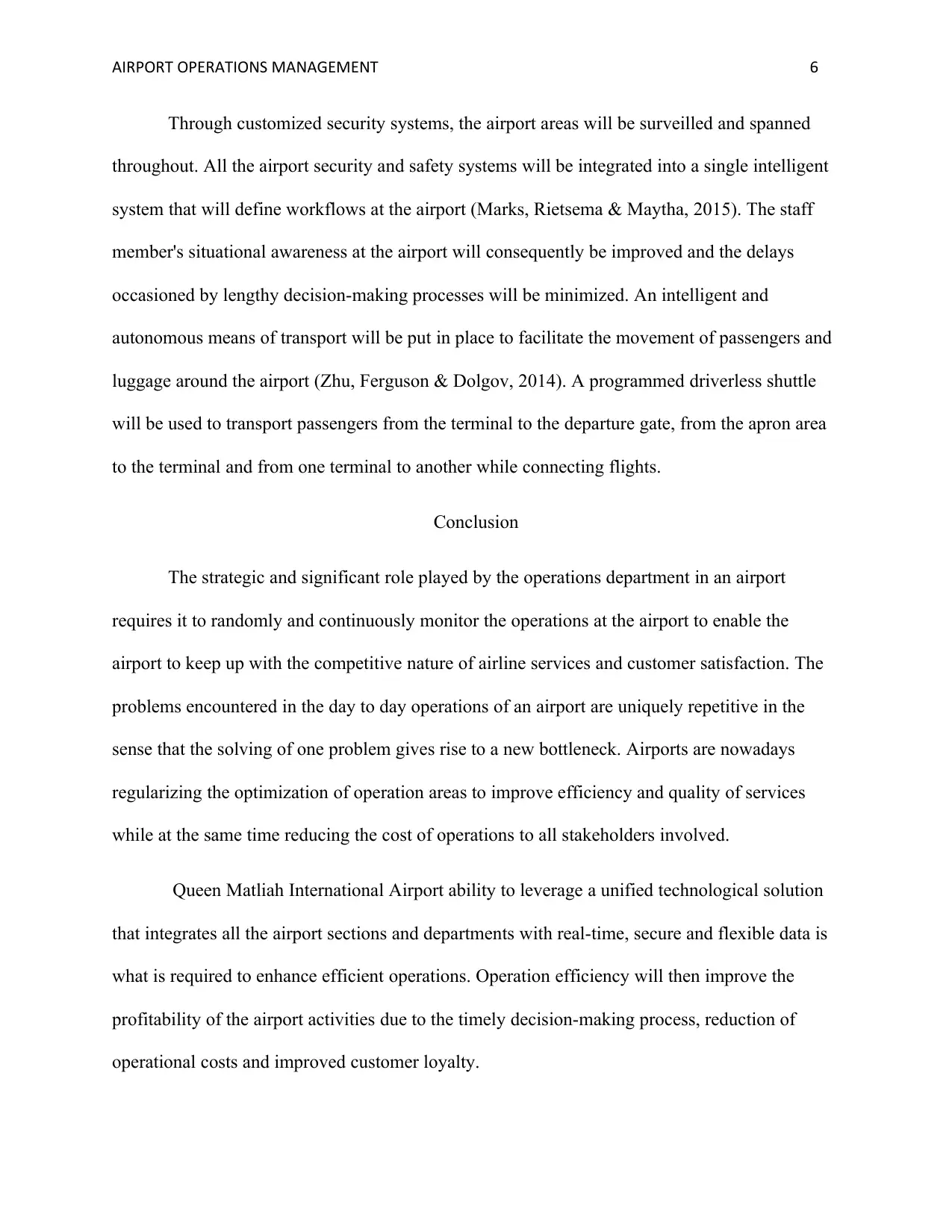
AIRPORT OPERATIONS MANAGEMENT 6
Through customized security systems, the airport areas will be surveilled and spanned
throughout. All the airport security and safety systems will be integrated into a single intelligent
system that will define workflows at the airport (Marks, Rietsema & Maytha, 2015). The staff
member's situational awareness at the airport will consequently be improved and the delays
occasioned by lengthy decision-making processes will be minimized. An intelligent and
autonomous means of transport will be put in place to facilitate the movement of passengers and
luggage around the airport (Zhu, Ferguson & Dolgov, 2014). A programmed driverless shuttle
will be used to transport passengers from the terminal to the departure gate, from the apron area
to the terminal and from one terminal to another while connecting flights.
Conclusion
The strategic and significant role played by the operations department in an airport
requires it to randomly and continuously monitor the operations at the airport to enable the
airport to keep up with the competitive nature of airline services and customer satisfaction. The
problems encountered in the day to day operations of an airport are uniquely repetitive in the
sense that the solving of one problem gives rise to a new bottleneck. Airports are nowadays
regularizing the optimization of operation areas to improve efficiency and quality of services
while at the same time reducing the cost of operations to all stakeholders involved.
Queen Matliah International Airport ability to leverage a unified technological solution
that integrates all the airport sections and departments with real-time, secure and flexible data is
what is required to enhance efficient operations. Operation efficiency will then improve the
profitability of the airport activities due to the timely decision-making process, reduction of
operational costs and improved customer loyalty.
Through customized security systems, the airport areas will be surveilled and spanned
throughout. All the airport security and safety systems will be integrated into a single intelligent
system that will define workflows at the airport (Marks, Rietsema & Maytha, 2015). The staff
member's situational awareness at the airport will consequently be improved and the delays
occasioned by lengthy decision-making processes will be minimized. An intelligent and
autonomous means of transport will be put in place to facilitate the movement of passengers and
luggage around the airport (Zhu, Ferguson & Dolgov, 2014). A programmed driverless shuttle
will be used to transport passengers from the terminal to the departure gate, from the apron area
to the terminal and from one terminal to another while connecting flights.
Conclusion
The strategic and significant role played by the operations department in an airport
requires it to randomly and continuously monitor the operations at the airport to enable the
airport to keep up with the competitive nature of airline services and customer satisfaction. The
problems encountered in the day to day operations of an airport are uniquely repetitive in the
sense that the solving of one problem gives rise to a new bottleneck. Airports are nowadays
regularizing the optimization of operation areas to improve efficiency and quality of services
while at the same time reducing the cost of operations to all stakeholders involved.
Queen Matliah International Airport ability to leverage a unified technological solution
that integrates all the airport sections and departments with real-time, secure and flexible data is
what is required to enhance efficient operations. Operation efficiency will then improve the
profitability of the airport activities due to the timely decision-making process, reduction of
operational costs and improved customer loyalty.
⊘ This is a preview!⊘
Do you want full access?
Subscribe today to unlock all pages.

Trusted by 1+ million students worldwide
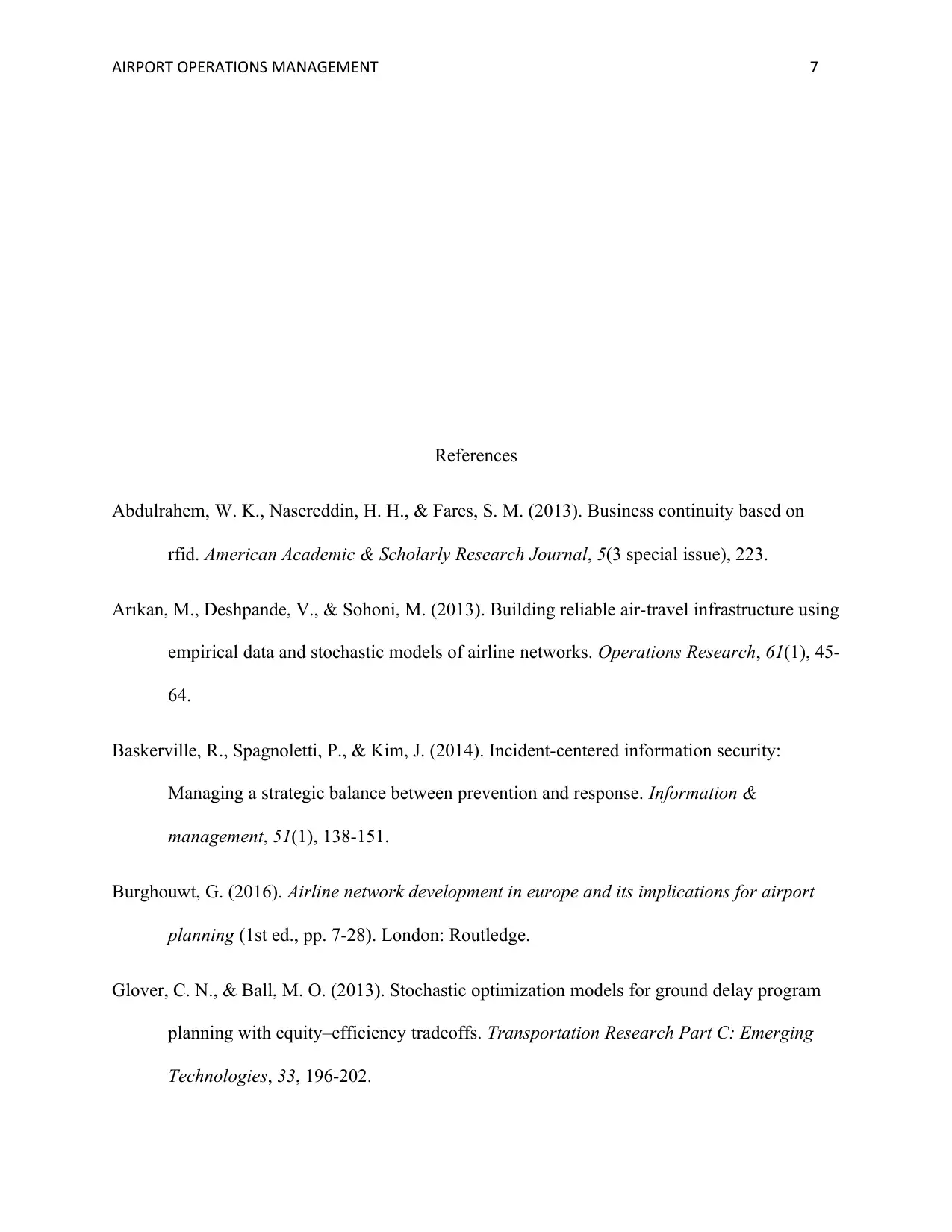
AIRPORT OPERATIONS MANAGEMENT 7
References
Abdulrahem, W. K., Nasereddin, H. H., & Fares, S. M. (2013). Business continuity based on
rfid. American Academic & Scholarly Research Journal, 5(3 special issue), 223.
Arıkan, M., Deshpande, V., & Sohoni, M. (2013). Building reliable air-travel infrastructure using
empirical data and stochastic models of airline networks. Operations Research, 61(1), 45-
64.
Baskerville, R., Spagnoletti, P., & Kim, J. (2014). Incident-centered information security:
Managing a strategic balance between prevention and response. Information &
management, 51(1), 138-151.
Burghouwt, G. (2016). Airline network development in europe and its implications for airport
planning (1st ed., pp. 7-28). London: Routledge.
Glover, C. N., & Ball, M. O. (2013). Stochastic optimization models for ground delay program
planning with equity–efficiency tradeoffs. Transportation Research Part C: Emerging
Technologies, 33, 196-202.
References
Abdulrahem, W. K., Nasereddin, H. H., & Fares, S. M. (2013). Business continuity based on
rfid. American Academic & Scholarly Research Journal, 5(3 special issue), 223.
Arıkan, M., Deshpande, V., & Sohoni, M. (2013). Building reliable air-travel infrastructure using
empirical data and stochastic models of airline networks. Operations Research, 61(1), 45-
64.
Baskerville, R., Spagnoletti, P., & Kim, J. (2014). Incident-centered information security:
Managing a strategic balance between prevention and response. Information &
management, 51(1), 138-151.
Burghouwt, G. (2016). Airline network development in europe and its implications for airport
planning (1st ed., pp. 7-28). London: Routledge.
Glover, C. N., & Ball, M. O. (2013). Stochastic optimization models for ground delay program
planning with equity–efficiency tradeoffs. Transportation Research Part C: Emerging
Technologies, 33, 196-202.
Paraphrase This Document
Need a fresh take? Get an instant paraphrase of this document with our AI Paraphraser
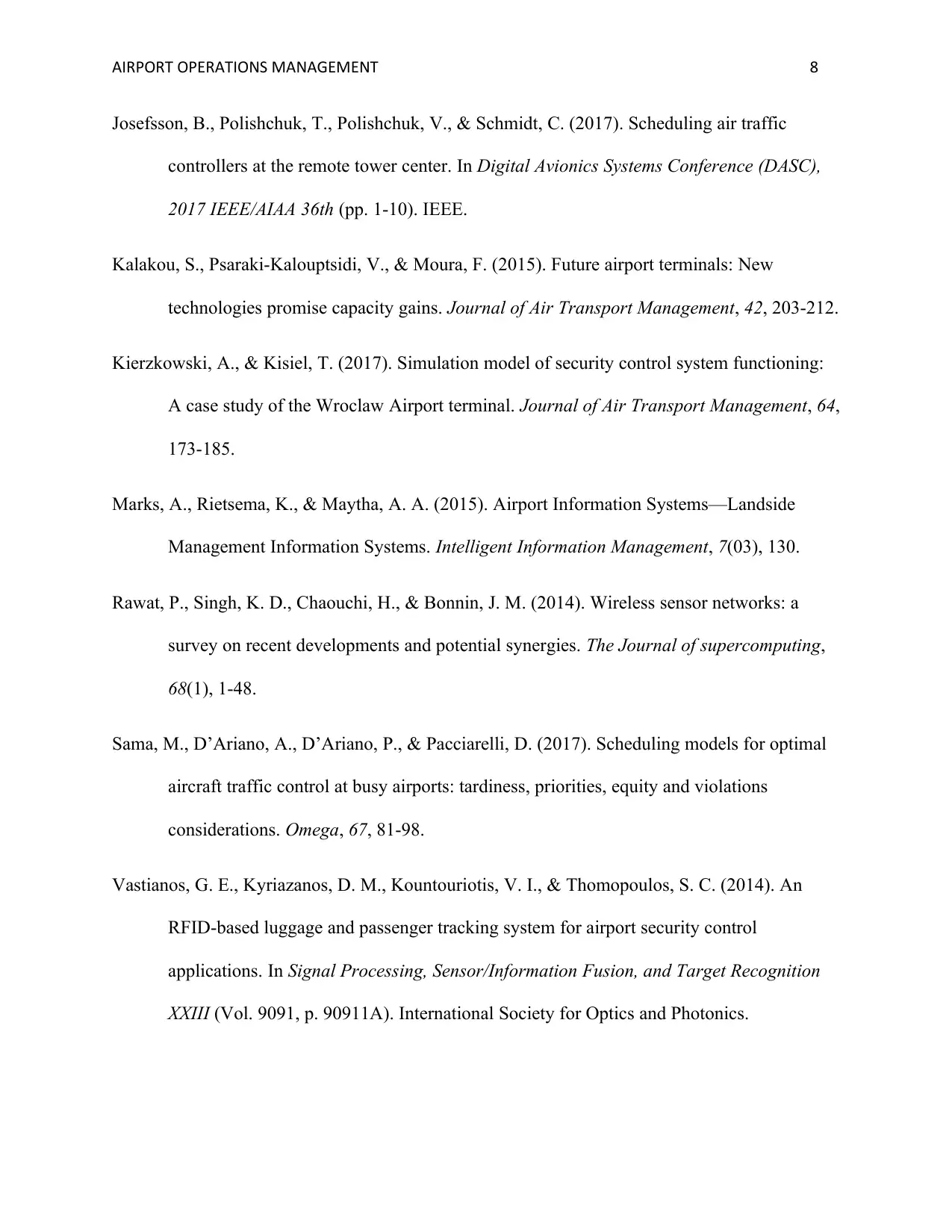
AIRPORT OPERATIONS MANAGEMENT 8
Josefsson, B., Polishchuk, T., Polishchuk, V., & Schmidt, C. (2017). Scheduling air traffic
controllers at the remote tower center. In Digital Avionics Systems Conference (DASC),
2017 IEEE/AIAA 36th (pp. 1-10). IEEE.
Kalakou, S., Psaraki-Kalouptsidi, V., & Moura, F. (2015). Future airport terminals: New
technologies promise capacity gains. Journal of Air Transport Management, 42, 203-212.
Kierzkowski, A., & Kisiel, T. (2017). Simulation model of security control system functioning:
A case study of the Wroclaw Airport terminal. Journal of Air Transport Management, 64,
173-185.
Marks, A., Rietsema, K., & Maytha, A. A. (2015). Airport Information Systems—Landside
Management Information Systems. Intelligent Information Management, 7(03), 130.
Rawat, P., Singh, K. D., Chaouchi, H., & Bonnin, J. M. (2014). Wireless sensor networks: a
survey on recent developments and potential synergies. The Journal of supercomputing,
68(1), 1-48.
Sama, M., D’Ariano, A., D’Ariano, P., & Pacciarelli, D. (2017). Scheduling models for optimal
aircraft traffic control at busy airports: tardiness, priorities, equity and violations
considerations. Omega, 67, 81-98.
Vastianos, G. E., Kyriazanos, D. M., Kountouriotis, V. I., & Thomopoulos, S. C. (2014). An
RFID-based luggage and passenger tracking system for airport security control
applications. In Signal Processing, Sensor/Information Fusion, and Target Recognition
XXIII (Vol. 9091, p. 90911A). International Society for Optics and Photonics.
Josefsson, B., Polishchuk, T., Polishchuk, V., & Schmidt, C. (2017). Scheduling air traffic
controllers at the remote tower center. In Digital Avionics Systems Conference (DASC),
2017 IEEE/AIAA 36th (pp. 1-10). IEEE.
Kalakou, S., Psaraki-Kalouptsidi, V., & Moura, F. (2015). Future airport terminals: New
technologies promise capacity gains. Journal of Air Transport Management, 42, 203-212.
Kierzkowski, A., & Kisiel, T. (2017). Simulation model of security control system functioning:
A case study of the Wroclaw Airport terminal. Journal of Air Transport Management, 64,
173-185.
Marks, A., Rietsema, K., & Maytha, A. A. (2015). Airport Information Systems—Landside
Management Information Systems. Intelligent Information Management, 7(03), 130.
Rawat, P., Singh, K. D., Chaouchi, H., & Bonnin, J. M. (2014). Wireless sensor networks: a
survey on recent developments and potential synergies. The Journal of supercomputing,
68(1), 1-48.
Sama, M., D’Ariano, A., D’Ariano, P., & Pacciarelli, D. (2017). Scheduling models for optimal
aircraft traffic control at busy airports: tardiness, priorities, equity and violations
considerations. Omega, 67, 81-98.
Vastianos, G. E., Kyriazanos, D. M., Kountouriotis, V. I., & Thomopoulos, S. C. (2014). An
RFID-based luggage and passenger tracking system for airport security control
applications. In Signal Processing, Sensor/Information Fusion, and Target Recognition
XXIII (Vol. 9091, p. 90911A). International Society for Optics and Photonics.
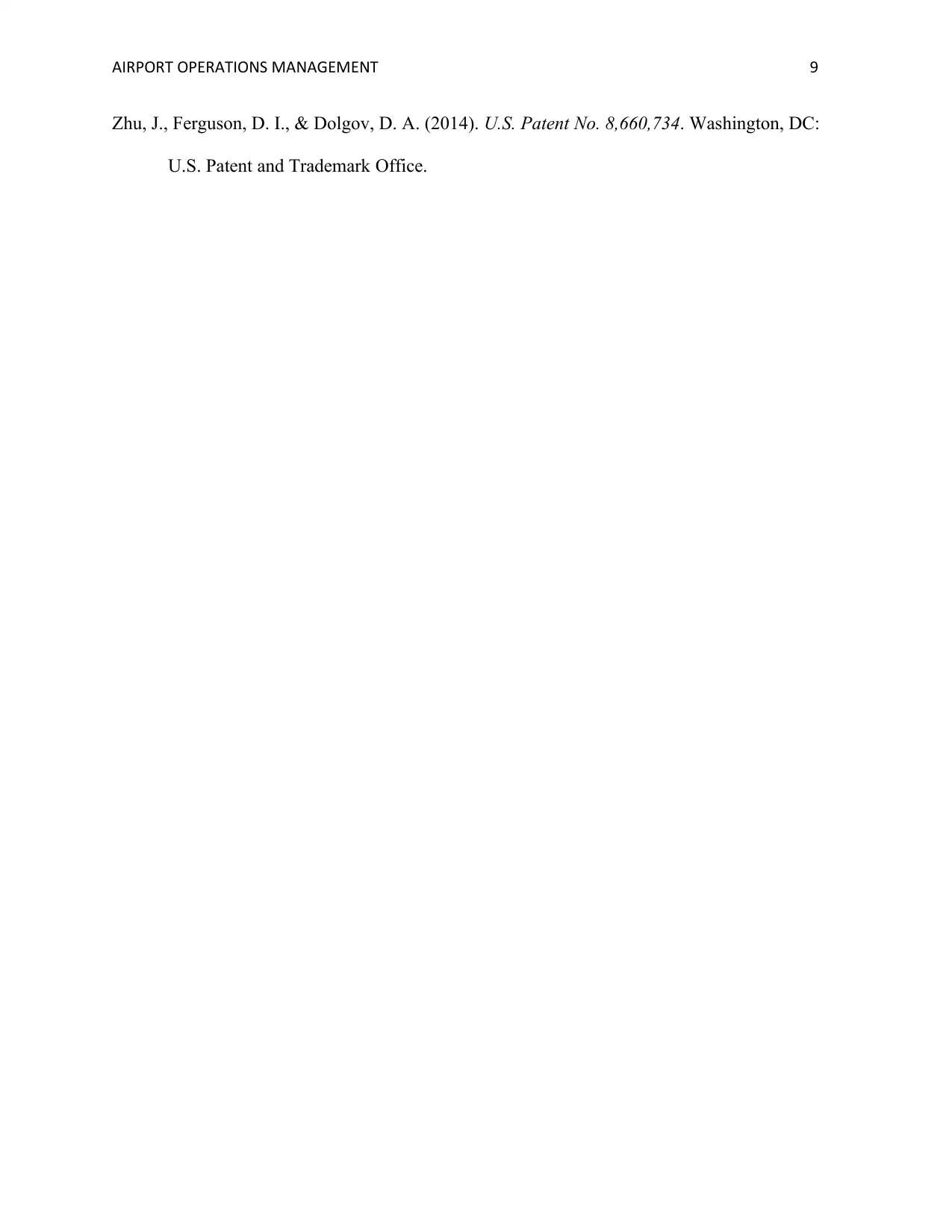
AIRPORT OPERATIONS MANAGEMENT 9
Zhu, J., Ferguson, D. I., & Dolgov, D. A. (2014). U.S. Patent No. 8,660,734. Washington, DC:
U.S. Patent and Trademark Office.
Zhu, J., Ferguson, D. I., & Dolgov, D. A. (2014). U.S. Patent No. 8,660,734. Washington, DC:
U.S. Patent and Trademark Office.
⊘ This is a preview!⊘
Do you want full access?
Subscribe today to unlock all pages.

Trusted by 1+ million students worldwide
1 out of 9
Related Documents
Your All-in-One AI-Powered Toolkit for Academic Success.
+13062052269
info@desklib.com
Available 24*7 on WhatsApp / Email
![[object Object]](/_next/static/media/star-bottom.7253800d.svg)
Unlock your academic potential
Copyright © 2020–2025 A2Z Services. All Rights Reserved. Developed and managed by ZUCOL.





